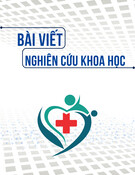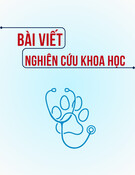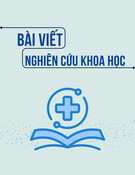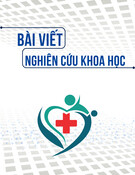
THAI BINH JOURNAL OF MEDICAL AND PHARMACY, VOLUME 14, ISSUE 5 - DECEMBER 2024
41
CHARACTERISTICS OF HEART PATTERNS ACCORDING TO TRADITIONAL
MEDICINE IN PATIENTS WITH CARDIOVASCULAR DISEASE
Tran Thi Thu Thuong1, Nguyen Thi Kim Lien2*,
Nguyen Quang Tam2, Truong Mai Vinh Thoai3
1. 17 Millitary Hospital, Da Nang
2. Hue University of Medicine and Pharmacy,
Hue University
3. Traditional medicine student, Hue University of
Medicine and Pharmacy, Hue University
*Corresponding author: Nguyen Thi Kim Lien
Email: ntklien@huemed-univ.edu.vn
Received date: 12/11/2024
Revised date: 12/12/2024
Accepted date: 15/12/2024
ABSTRACT
Objective: To investigate the characteristics of
heart patterns according to traditional medicine and
to examine the relationship between pro-BNP, EF
indices, and the occurrence of these syndromes in
patients with cardiovascular disease.
Method: A cross-sectional descriptive study
was conducted on 180 patients diagnosed with
chronic coronary syndrome and/or chronic heart
failure, who were undergoing inpatient treatment
at the Cardiology Department of Hue University of
Medicine and Pharmacy Hospital.
Results: The syndromes of Heart Qi deficiency,
Heart Qi and Blood deficiency, and Heart Qi and
Yin deficiency were among the most commonly
observed, with a prevalence rate exceeding 80%. In
contrast, the syndrome of Upward flaming of heart
fire was the least prevalent, occurring at a rate of
1.1%. The moderate level occurred at the highest
rate in these three syndromes: Heart Qi deficiency,
Deficiency of heart Qi and Blood, and Deficiency
of heart Qi and Yin; the average score of the level
was also the highest in these three syndromes.
Individuals with a Deficiency of heart Qi and Yang
pattern exhibited higher pro-BNP levels than those
without this syndrome. Conversely, individuals with
Water retention affecting the heart pattern showed
lower EF levels than those without this syndrome.
Individuals with the Heart Yang deficiency pattern
had lower pro-BNP levels compared to those
without the syndrome. Additionally, individuals with
the Disharmony between the heart and kidney
pattern and Heart and spleen deficiency pattern
demonstrated higher EF levels compared to those
without these syndromes (p < 0.05).
Conclusion: Heart Qi deficiency, Heart Qi and
Blood deficiency, and Heart Qi and Yin deficiency
were prevalent patterns with the most significant
impact. There were significant differences in pro-
BNP and EF levels between individuals with and
without the patterns of Deficiency of heart Qi and
Yang, Water retention affecting the heart, Heart
Yang deficiency, Disharmony between the heart and
kidney pattern, and Heart and spleen deficiency.
Keywords: Chronic coronary syndrome, chronic
heart failure, heart organ, traditional medicine
I. INTRODUCTION
Cardiovascular diseases have been and continue
to be a major global health issue, with high mortality
rates. According to estimates from the World
Health Organization, approximately 17.9 million
people die from cardiovascular diseases each
year, accounting for 31% of total global deaths.
Among cardiovascular diseases, coronary artery
disease and heart failure were conditions with
high morbidity and mortality rates. Coronary artery
disease alone accounts for 14% of global mortality
and is a leading cause of reduced life expectancy
[1]. Community studies have shown that 30-40%
of patients die within one year, and 60-70% die
within five years after being diagnosed with heart
failure [2]. Therefore, accurate diagnosis and early
treatment of coronary artery disease and heart
failure were crucial to increase life expectancy and
improve the quality of life for patients.
In traditional medicine, cardiovascular diseases
were often characterized by pathological
manifestations primarily associated with the “heart
organ”. The heart organ functions as the principal
controller of blood vessels, encompassing two
primary aspects: governing blood and governing
vessels. These roles contribute to the distribution
and circulation of blood within the vascular
system. The heart also functions as a continuously
contracting organ, propelling blood throughout
the entire body, and thereby driving circulatory
dynamics. This activity facilitates the systemic
distribution and circulation of blood, essential for
maintaining bodily functions. Together, the heart,
blood vessels, and blood create a unified circulatory
system, with the heart serving as the primary driving
force within this network [3]. In traditional medicine,

THAI BINH JOURNAL OF MEDICAL AND PHARMACY, VOLUME 14, ISSUE 5 - DECEMBER 2024
42
diagnostic evaluations primarily rely on clinical
examinations, with minimal use of ancillary testing.
This reliance can result in delayed detection of
disease, thereby impacting treatment quality. With
the continuous advancements in evidence-based
medicine, exploring the relationship between
traditional medicine syndromes and highly sensitive
and specific laboratory indices was increasingly
essential. Such an approach enables more accurate
and timely diagnoses, thereby enhancing treatment
outcomes. At present, research exploring the
theoretical connections between the “heart organ”
in traditional medicine and cardiovascular diseases
remains limited. Additionally, there was a lack of
standardized, objective criteria for classifying and
diagnosing symptoms and syndromes within this
framework. Based on the above theoretical and
practical foundations, we conducted this study with
two objectives:
(1) To investigate the characteristics of heart
patterns according to traditional medicine in
patients with cardiovascular diseases at the Hue
University of Medicine and Pharmacy Hospital.
(2) To examine the relationship between pro-
BNP, EF indices, and the occurrence of heart organ
syndromes in patients with cardiovascular diseases
at the Hue University of Medicine and Pharmacy
Hospital.
II. SUBJECTS AND METHODS
Research subjects
Patients diagnosed with chronic coronary
syndrome (CCS) and/or chronic heart failure
(CHF) who were receiving inpatient treatment at
the Department of Cardiology, Hue University of
Medicine and Pharmacy Hospital.
2.1.1. Inclusion Criteria
- Patients diagnosed with chronic heart failure
according to the ESC 2021 guidelines [4].
- Patients diagnosed with chronic coronary
syndrome according to the ESC 2019 guidelines [5].
- Patients who agree and voluntarily participate
in the study.
Exclusion Criteria
- Patients who were unable to hear, understand,
or respond to questions during the examination.
- Patients who were physically debilitated or had
signs of mental disorders.
Research Methodology
Study Design: Cross-sectional descriptive study.
Sample Size and Sampling Method:
Convenience sampling method: all patients who
meet the inclusion criteria during the study period.
The total sample size collected was 180 patients.
Study Duration and Location: From August
2023 to April 2024 at the Department of Cardiology,
Hue University of Medicine and Pharmacy Hospital.
Research Tools
- A pre-prepared research form, including
sections on: general information, Characteristics
of examination according to modern medicine and
traditional medicine
- Medical records, ALPK2 blood pressure monitor,
stethoscope, tongue depressor, thermometer,
stopwatch, and weighing scale, as well as height
and weight measuring tools.
Research Content
- Survey of the characteristics of heart patterns
according to traditional medicine: Based on the
diagnostic guidelines for common syndromes
in Traditional Chinese Medicine, a survey was
conducted on the occurrence of 12 patterns related
to the heart organ: Heart Yin deficiency pattern
(HYiDP), Heart Qi deficiency pattern (HQDP),
Deficiency of heart Qi and blood pattern (DHQBP),
Deficiency of heart Qi and Yin pattern (DHQYiP),
Heart Yang deficiency pattern (HYaDP), Deficiency
of heart Qi and Yang pattern (DHQYaP), Heart
vessels stasis pattern (HVSP), Phlegm obstructing
the heart vessels pattern (POHVP), Upward
flaming of heart fire pattern (UFHRP), Disharmony
between the heart and kidney pattern (DBHKP),
Water retention affecting the heart pattern
(WRAHP), Heart and spleen deficiency pattern
(HSDP). The syndromes were evaluated based
on the symptoms present within each syndrome.
Each symptom was assigned a different score
depending on its importance within the syndrome.
The score for each symptom was calculated by
multiplying its value by 0.7 (if the symptom was
mild), by 1 (if the symptom was moderate), or by
1.5 (if the symptom was severe). The total score
for each syndrome was the sum of the scores of
all symptoms included in that syndrome. If the total
score for a syndrome was 14 points or higher, the
syndrome was considered present. If the score was
below 14 points, it was considered normal. Within
each syndrome, the severity was classified based
on the total score: a score of 14–20.9 indicates mild

THAI BINH JOURNAL OF MEDICAL AND PHARMACY, VOLUME 14, ISSUE 5 - DECEMBER 2024
43
severity, 21–30 points indicates moderate severity
and a score greater than 30 points indicates severe
severity [6].
- Investigate the relationship between pro-BNP,
EF levels, and the occurrence of heart organ
syndromes according to traditional medicine.
Data Analysis and Processing:
The collected data is entered, cleaned, analyzed,
and processed using SPSS 20.0 statistical
software. Qualitative variables were expressed
as percentages. Quantitative variables were
presented as mean ± standard deviation (mean
±SD). The normal distribution of variables was
tested using the Skewness and Kurtosis indexes.
Variables with normal distribution were compared
by using One-way ANOVA or Independent-Samples
t-test. Variables without normal distribution
were compared by using the Kruskal-Wallis H or
Mann-Whitney U test. Results were considered
statistically significant if p-value <0.05.
Research Ethics
This research was the product of the University-
level science and technology project (University of
Medicine and Pharmacy, Hue University) with code
102/24, which has been evaluated and licensed by
the council. The study was conducted only after
obtaining informed consent from the research
participants. All collected information was kept
confidential and used solely for research purposes.
III. RESULTS
General characteristics of the study subjects
Table 1. General characteristics of the study subjects
Characteristics n = 180 %
Gender Male 79 43.9
Female 101 56.1
Age
< 40 0 0.0
40- 59 31 17.2
60-69 49 27.2
70-79 49 27.2
≥ 80 51 28.4
Mean±SD 71.9±12.4
BMI
(kg/m2)
<18,5 27 15.0
18,5- 22,9 93 51.7
≥23 60 33.3
Mean ±SD 21.8±3.3
The proportion of females (56.1%) was higher than that of males (43.9%). All research participants
were over 40 years old, with an average age of 71.9 ± 12.4 years. In terms of body mass index (BMI),
the highest proportion of participants fell within the normal weight range (51.7%), while a significant
proportion were overweight or obese (33.3%).
3.2. Characteristics of heart patterns
Table 2. Distribution of heart patterns
Patterns
Total
(n = 180)
CCS
(n=62)
(a)
CHF
(n= 59)
(b)
CCS + CHF
(n= 59)
(c)
p
(a-b-c)
n % n % n % n %
HYiDP 98 54.4 34 54.8 30 50.8 34 57.6 0.759
HQDP 152 84.4 56 90.3 46 78.0 50 84.7 0.172
DHQBP 161 89.4 60 96.8 51 86.4 50 84.7 0.065
DHQYiP 157 87.2 57 91.9 49 83.1 51 86.4 0.335
HYaDP 101 56.1 38 61.3 31 52.5 32 54.2 0.587
DHQYaP 141 78.3 51 82.3 43 72.9 47 79.7 0.437

THAI BINH JOURNAL OF MEDICAL AND PHARMACY, VOLUME 14, ISSUE 5 - DECEMBER 2024
44
Patterns
Total
(n = 180)
CCS
(n=62)
(a)
CHF
(n= 59)
(b)
CCS + CHF
(n= 59)
(c)
p
(a-b-c)
n % n % n % n %
HVSP 63 35.0 21 33.9 19 32.2 23 39.0 0.723
POHVP 92 51.1 39 62.9 26 44.1 27 45.8 0.071
UFHRP 2 1.1 0 0.0 1 1.7 1 1.7 0.546
DBHKP 77 42.8 31 50.0 22 37.3 24 40.7 0.341
WRAHP 128 71.1 46 74.2 42 71.2 40 67.8 0.740
HSDP 127 70.6 52 83.9 35 59.3 40 67.8 0.011
Notes: Heart Yin deficiency pattern (HYiDP), Heart Qi deficiency pattern
(HQDP), Deficiency of heart Qi and blood pattern (DHQBP), Deficiency of
heart Qi and Yin pattern (DHQYiP), Heart Yang deficiency pattern (HYaDP),
Deficiency of heart Qi and Yang pattern (DHQYaP), Heart vessels stasis
pattern (HVSP), Phlegm obstructing the heart vessels pattern (POHVP),
Upward flaming of heart fire pattern (UFHRP), Disharmony between the
heart and kidney pattern (DBHKP), Water retention affecting the heart pattern
(WRAHP), Heart and spleen deficiency pattern (HSDP).
HQDP, DHQBP, and DHQYiP were the most common patterns, with prevalence rates above 80%. The
next most common syndromes were HYiDP, HYaDP, DHQYaP, POHVP, WRAHP, and HSDP, all of which
appeared at relatively high rates (above 50%). The least common pattern, UFHRP, was observed in only
1.1% of cases.
Overall, most of the heart organ patterns showed no significant differences in distribution across the
three patient groups (p > 0.05). However, HSDP exhibited a significant difference between the three
groups (p < 0.05).
Table 3. Degree of heart patterns
Patterns Total
(n = 180)
CCS
(n=62)
(1)
CHF
(n= 59)
(2)
CCS + CHF
(n= 59)
(3) p (1-2-3)
% X±SD % X±SD % X±SD % X±SD
HYiDP
mild 43.3 14.6 ±
5.7
43.5 14.8 ±
4.7
37.3 14.4 ±
6.6
49.2 14.6 ±
5.6
0.908
moderate 9.4 11.3 8.5 8.5
severe 1.7 0.0 5.1 0.0
HQDP
mild 33.3
20.5 ±
6.5
37.1
20.5 ±
4.8
27.1
20.9 ±
7.1
35.6
20.0 ±
7.4
0.809
moderate 46.1 53.2 42.4 42.4
severe 5.0 0.0 8.5 6.8
DHQBP
mild 29.4
21.5 ±
6.1
19.4
22.8 ±
3.8
42.4
20.5 ±
6.8
27.1
21.2 ±
7.2
0.052
moderate 53.3 77.4 35.6 45.8
severe 6.7 0.0 8.5 11.9
DHQYiP
mild 32.8 21.3 ±
6.9
32.3 21.1 ±
5.2
39.0 21.3 ±
7.8
27.1 21.4 ±
7.6 0.974
moderate 45.6 58.1 28.8 49.2
severe 8.9 1.6 15.3 10.2
HYaDP
mild 42.2
15.1 ±
5.3
46.8
15.3 ±
4.6
33.9
15.5 ±
6.3
45.8
14.6 ±
4.8
0.588
moderate 13.3 14.5 16.9 8.5
severe 0.6 0.0 1.7 0.0

THAI BINH JOURNAL OF MEDICAL AND PHARMACY, VOLUME 14, ISSUE 5 - DECEMBER 2024
45
Patterns Total
(n = 180)
CCS
(n=62)
(1)
CHF
(n= 59)
(2)
CCS + CHF
(n= 59)
(3) p (1-2-3)
% X±SD % X±SD % X±SD % X±SD
DHQYaP
mild 52.8
18.3 ±
13.1
64.5
17.2 ±
3.9
40.7
17.8 ±
6.2
52.5
19.7 ±
21.7
0.811
moderate 24.4 17.7 30.5 25.4
severe 1.1 0.0 1.7 1.7
HVSP
mild 23.9 11.1 ±
7.2
25.8
10.7 ±
7.0
15.3
11.6 ±
8.0
30.5
11.0 ±
6.6
0.788
moderate 10.6 8.1 15.3 8.5
severe 0.6 0.0 1.7 0.0
POHVP
mild 36.7
14.4 ±
6.5
53.2
15.1 ±
6.1
27.1
14.2 ±
6.5
28.8
13.9 ±
7.0 0.518moderate 11.7 4.8 9 15.3 15.3
severe 2.8 4.8 1.7 1.7
UFHRP
mild 1.1
5.5 ± 3.3
0.0
6.1 ± 3.0
1.7
5.7 ± 3.7
1.7
4.8 ±
3.1
0.087
moderate 0.0 0.0 0.0 0.0
severe 0.0 0.0 0.0 0.0
DBHKP
mild 37.8
13.3 ±
4.3
50.0
13.8 ±
3.4
28.8
13.0 ±
5.0
33.9
13.1 ±
4.4 0.473
moderate 5.0 0.0 8.5 6.8
severe 0.0 0.0 0.0 0.0
WRAHP
mild 43.9
17.3 ±
5.7
67.7
15.8 ±
4.2
28.8
18.3 ±
6.0
33.9
17.8 ±
6.4 p2-3=0.02
moderate 25.6 6.5 40.7 30.5
severe 1.7 0.0 1.7 3.4
HSDP
mild 55.6
16.1 ±
4.5
72.6
17.1 ±
2.9
45.8
15.2 ±
5.0
47.5
15.9 ±
5.1 0.08
moderate 15.0 11.3 13.6 20.3
severe 0.0 0.0 0.0 0.0
Notes: Heart Yin deficiency pattern (HYiDP), Heart Qi deficiency pattern (HQDP), Deficiency of
heart Qi and blood pattern (DHQBP), Deficiency of heart Qi and Yin pattern (DHQYiP), Heart Yang
deficiency pattern (HYaDP), Deficiency of heart Qi and Yang pattern (DHQYaP), Heart vessels stasis
pattern (HVSP), Phlegm obstructing the heart vessels pattern (POHVP), Upward flaming of heart
fire pattern (UFHRP), Disharmony between the heart and kidney pattern (DBHKP), Water retention
affecting the heart pattern (WRAHP), Heart and spleen deficiency pattern (HSDP).
The syndromes HYiDP, HYaDP, DHQYaP, HVSP, POHVP, and DBHKP all had the highest proportion of
“mild severity” across all three patient groups. The syndromes HQDP, DHQBP, and DHQYiP predominantly
appeared with “moderate severity” in all three groups, and had the highest average scores among the 12
syndromes, ranging from 20.0 ± 7.4 to 22.8 ± 3.8.
There was a difference in the mean score of the WRAHP between the CHF group and the CCS+CHF
group (p<0.05).
3.3. The relationship between pro-BNP and EF index with the occurrence of heart organ syn-
dromes in patients with cardiovascular diseases

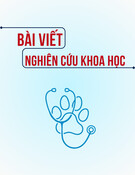





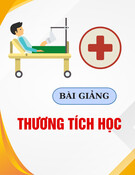



![Tài liệu Triệu chứng học nội khoa [mới nhất]](https://cdn.tailieu.vn/images/document/thumbnail/2025/20251204/oanhlahet@gmail.com/135x160/5231764900514.jpg)
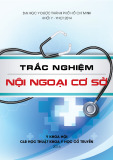

![Bài giảng Vi sinh vật: Đại cương về miễn dịch và ứng dụng [chuẩn nhất]](https://cdn.tailieu.vn/images/document/thumbnail/2025/20251124/royalnguyen223@gmail.com/135x160/49791764038504.jpg)

